In our previous experiment, we discussed the candle covered with glass. The basic science behind was the oxygen limitation that made the candle go off.
In an extension of that science activity, I am now going to share another experiment with you. It is also to do with candles and glass, but with a twist.
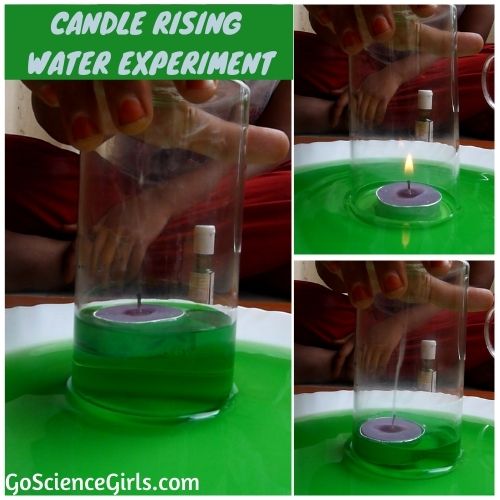
Apart from the oxygen limitation that puts the candle off, there is also low pressure created in the glass that leads to a vacuum.
This will cause some effects and that looks like magic to kids but the science to all adults. So let us do this magic to our kids and also explain them some science.
Things required
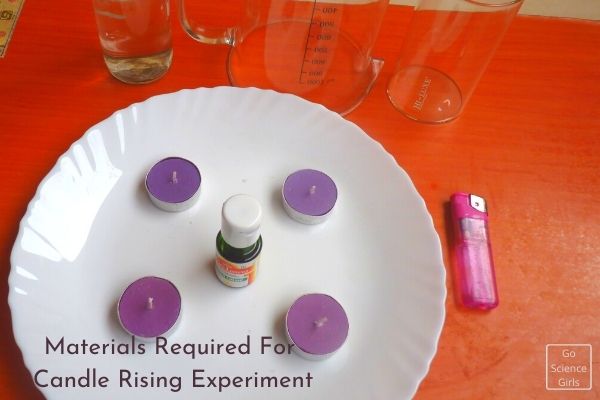
- Ceramic or glass plates
- Glass tumbler
- Candle
- Matchbox with stick
- Water
Steps involved
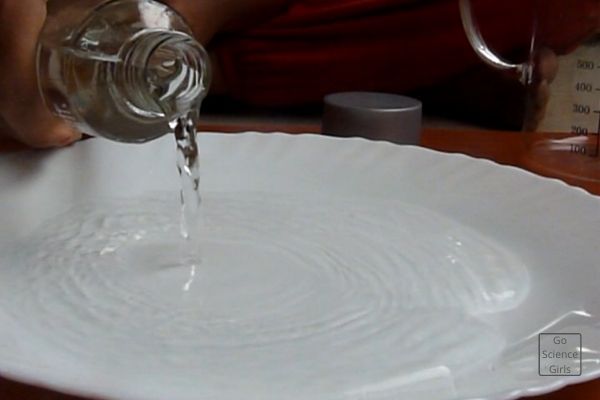
Fill the plate with water.

Place the candle on the plate and lit it. You can see the candle glowing brightly.
It may float or stand on the water in the plate based on the weight of the candle.
The presence of water does not make any difference to the candle at this stage.
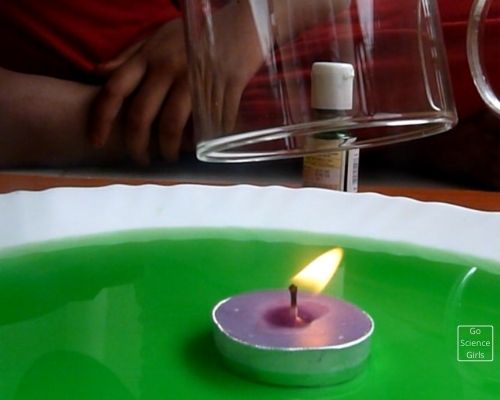
After sometime invert the glass tumbler and place it on the glowing candle.
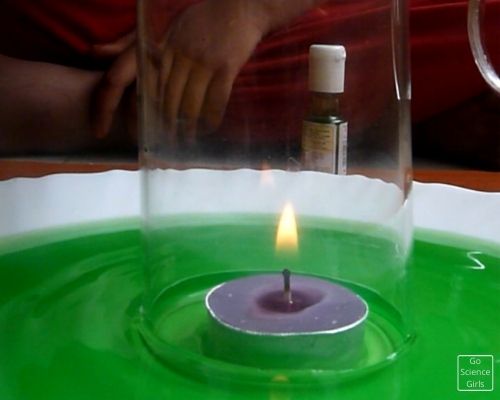
Imagine the glass will close the candle. In a few minutes, you can witness candle blowing off as the closed glass limits oxygen in the space surrounding the candle.
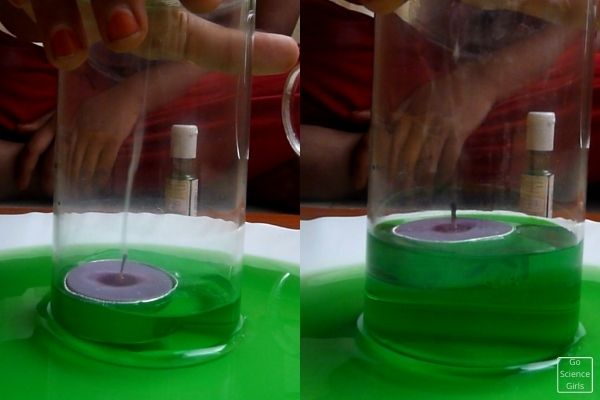
Another thing you will witness is now the water in the plate enters the glass and you will see the level rising constantly.
Science Behind Candle Rising Water
The basic science here is the lack of oxygen puts off the candle in step 2. At the same time lack of oxygen also lowers the atmospheric pressure and creates a vacuum.
This leads to the water entering the glass from the plate. You can see this like the water level rises in the glass.
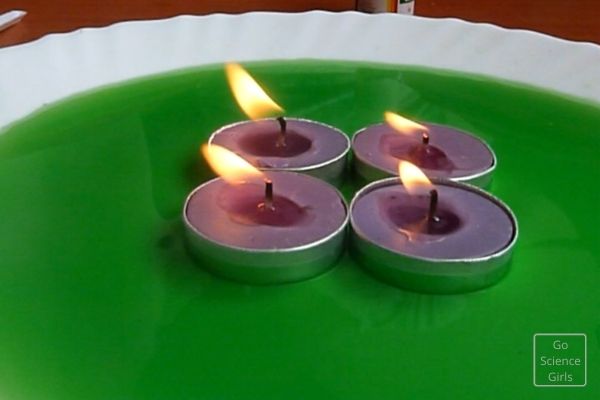
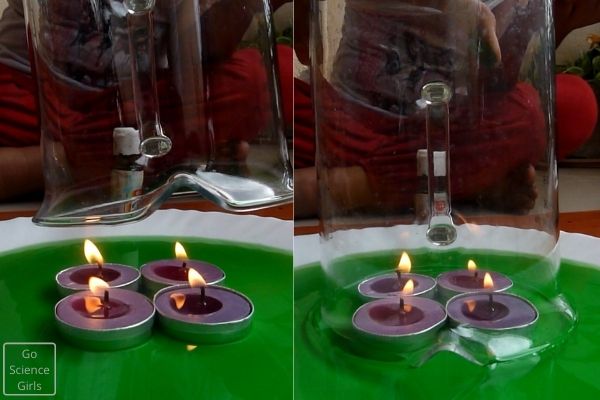
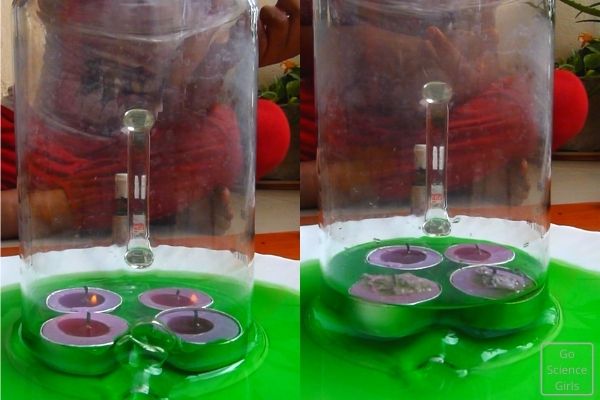
Detailed science with chemical equations
The water level rises to 1/10th of the glass before the candles go off is importantly you must note.
There is no air bubble formed. The water level will stay for few minutes once the candle goes off completely.
So both the candle dies out and water rises happens concurrently.
Chemical equation
Oxygen + Candle (wax/paraffin) à Water and Carbon dioxide
O2 + CnH2n+2 à H2O + CO2
I have an exercise for older kids here. Yes, ask your older kids to balance the chemical equation taking n as 1. Post the answers for learning.
The oxygen is 2 times more than the carbon dioxide released and hence the air volume reduces.
Let me also explain the physics behind this experiment for physics fans!
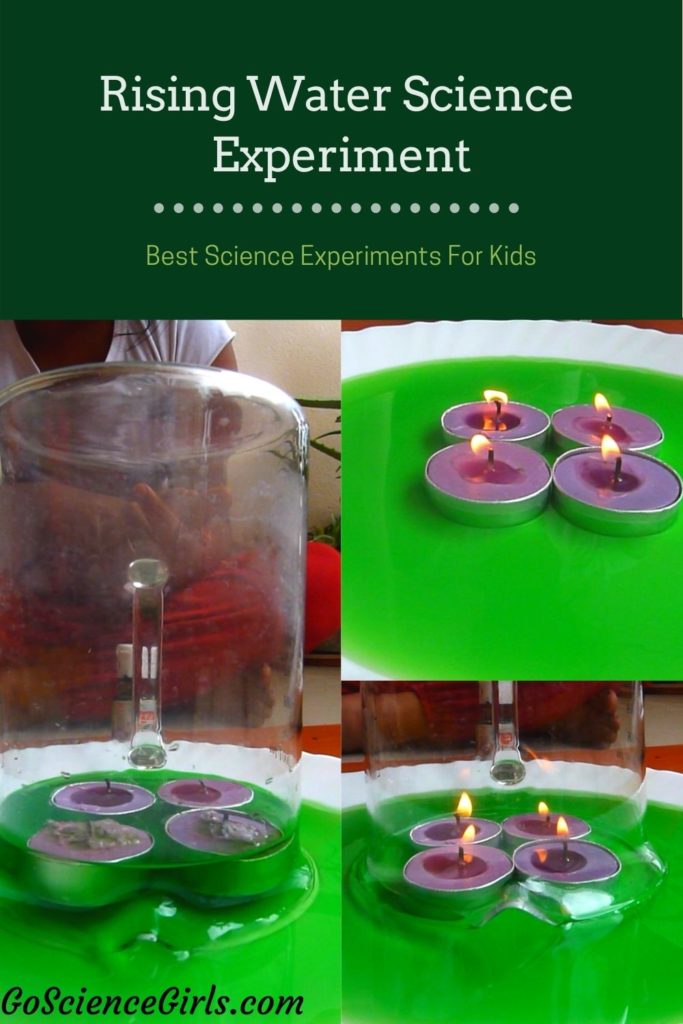
Physics facts
The burning candle produces heat which heats the air and thus expansion happens. This will cancel the oxygen depletion slowly and the water level remains down.
When oxygen gets saturated in the glass the candle goes off and the air begins to cool and volume decreases.
The reduction in air pressure will create a vacuum and hence water level rises.
Also, water initially is in the gas state when there is heat around and later it condenses and rises in level as water.
The same process or science is applied to how storms and hurricanes are formed.
When the sun heats up the air causing its density become low which is the reason for formation of wind and storms.
The high density air moves into the lower density air pockets. When there is enough wind referred to as ‘hurricanes’ causing the water rise and lifted up out of the ocean.
Age group
- This experiment is magic for kids aged 3 to 5.
- You can teach some science to kids 5 – 8 as they will know about oxygen etc.
- 8 -12-year-old kids can benefit from the chemical equations and the detailed science of this experiment.
Caution
As I always alert you, please make sure to assist or monitor kids when they do this experiment.
It involves fire and you must be around to avoid any accident. Also, dealing with glass dishes needs support which you must provide.
Depending on the age of your kid you decide whether you must take their help or help them or just be around. However, we advise you to be present irrespective of the kid’s age.
Interested in More Air Pressure Experiments? Explore the list below
FAQ
We have tried answering a few usual questions that might arise in the kid’s mind. My little one always ask questions upon which I fumble many times. So here you go with ready-made answers as well.
Twice the time of oxygen is burnt than the available CO2 that decreases the air pressure and hence water level rises. The air cools soon after flames go off and the molecules slow down making the water vapor condense to moisture.
The heat of the flame will start melting the wax near the wick and the liquid wax is drawn up to the wick due to capillary action. The flames heat will vaporize the wax and break them into molecules of oxygen and carbon.
The candle is put off by placing the lid on the candle that is lit. It is another way to extinguish the candle. The lid is placed on the flame which immediately cuts off the oxygen and thus puts off the candle.
The wick gets close to the glass the wax burns off and heats the glass. This might lead to the explosion of the glass. However, when water is kept on the glass this explosion is prevented.
As long as the pressure is low the water rises and when the pressure level equalizes the water level stops rising.
Place the glass flat on the plate to prevent air bubble forming. In case if it is tilted, then the air bubbles will form due to the difference in the pressure level between the inside and outside surface.
When you observe the tall and short burning candles closed with a glass container, surprisingly the tall candle goes out first because the carbon dioxide released travels upwards and suffocates the tall candle making the cold air sink. The short candle utilizes the oxygen in this cold air and stays on for some more time. When all the oxygen is used up, the short candle also dies.
Yes, place a candle in the bowl containing water and lit it. Slowly it goes down melting the wax which forms a protected wax around the wick. This allows the candle to stay on for good amount of time even though the flame has reached the level lower than the water. And of course, after a while water gets into wick and turns the flame off.
Modifications you can try with this experiment
Here are the few variations to further explore the scientific concepts in this experiment.
- Change the amount of water taken in the plate and observe how does it affects the water level rise.
- Discuss on what happened to the water when the candle is lit.
- How does temperature changes happen when we use different types of colored water?
- You can use colored water made of food coloring, milo, liquid dyes, powdered dye etc.
- Experiment on hot water versus cold water and observe the temperature and air pressure changes.
- Also try the experiment using two candles versus one candle or more candles etc.
- Use different liquids instead of water and check what are the changes and results.
- Try with different candle weight and height
- Change the glass to narrow and broad
- Make colored water and also increase/lower the water level in the plate
- Try not to lit a candle before and light it only after placing the glass. Yes, you need to lift it a bit and light it. Preheating is avoided to observe for any changes in the results.
Share the results with us that will let all our readers know what happens with all these modifications. In the meantime, I will also try different twists with my kids and post my experience.
